Source: CCTV.com
08-15-2006 13:43
 | |
 | |
汕 (Shan), meaning sand beach. It’s got water and mountain, and it is going to be our travel destination today. Welcome to Travelogue! I’m Xiaolan. In today’s Shantou trip, I will bring you to enjoy the precious sun shine, golden beach, and incredible ocean at Nan’ao Island; appreciate unique Chaoshan culture in these old residences; and explore the amazing history of this port city!
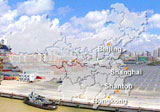 | |
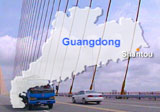 | |
Situated on the Chao-shan Plain in East Guangdong Province, Shantou is one of the key port cities in South China, a place of savvy business people and hometown of millions of overseas Chinese.
Shantou may not hit you with a bam like some exotic hideaways in China; the gentle aftertaste can linger on and on, just like sampling a cup of Chaoshan Kungfu tea.
Shantou was made an open seaport city in 1861 after the Opium War. Three rivers merge at the port, making it the only pass to get into Chao-shan plain from the sea at the time.
That explains why you will find a stone cannon fortress in downtown Shantou overlooking the bay.
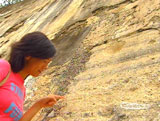 | |
“Really tall! Want to know what this material is made of? Remember a local rhyme, 紅糖糯米貝灰沙, hongtang is sugar; nuomi, glutinous rice; Beihuisha, a special construction material made of sand with sea shells.”
The ring-shaped fortress was built in 1874, consisting of two levels, with space that can store 18 cannons and station 2000 soldiers.
“Wow, the life was really hard for those soldiers, this tiny space was their bedroom!”
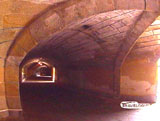 | |
And here looks like a storage place for cannons. It would be really stifling down here. Great, an air passageway! So the wind can blow down from above. The ventilator also serves another purpose.
“Can you hear me down there? The enemy boat is here, quick, get the cannons ready!”
So in case of emergency, the ventilators also served as the communication towers of the fortress.
It is said to be the only stairway that shaped like waves in the whole country. It was used to move the cannons from the basement level to the upper level.
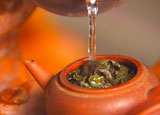 | |
When in Shantou, the first and last thing you will be asked to do is drinking tea. I mean drinking wherever you go, from dawn to dusk, and it’s known as nothing but Chaoshan Kungfu tea.
Local: “You need to be patient while enjoying Chaoshan kungfu tea.”
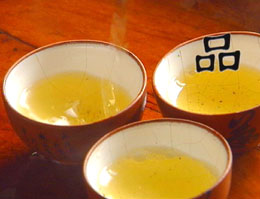 | |
According to traditional way, there are always three tea cups, and they are arranged in the shape of Chinese character 品, meaning Savor.
Let’s put it this way, don’t count on Kungfu tea while you are on the verge of dehydration. The complicated preparing ritual makes it more a way of socializing than thirst-quenching.
Local: You’re not supposed to point these two fingers outward while holding the cup.
Host: Why is that?
Local: Coz it’s rude to other people.
Shantou is a great place to seek out some quality leisure time - it’s got everything, mountain, ocean, and of course, world-class golf course.
 | |
Just 20-minute drive from Shantou downtown, the Citic golf club is a standard 18-hole course going 36-hole and is ranked within the top ten courses in the country.
You can also find plenty low maintenance fun going out and about, for example, adventuring into Guxueyan, a bunch of huge rocks at Chaoyang district.
The whole hill is like a Lego work built of grotesque rocks. There are hidden passages, large and small caves. The bizarre terrain could have been formulated millions years ago by the ocean.
“Exhausted, I really need a place to lie down, hey, looks like a perfect natural stone bed! It is said a famous monk in Tang Dynasty used to meditate here.”
“Amazing! The whole temple is built inside a stone cave!”
The temple is almost a case study of avant-garde design: three huge rocks made the roof and the walls of the main hall, the gap at the top serves as the skylight.
 | |
Master Shi Guangxu is the only monk practicing here. Well, sort of, he’s got a loyal companion here: a stone turtle. Master told me that local people believe that touching the turtle head can bring them luck in taking exams.
Like most places in china that’s got a rich cultural background, Chaoshan area also got its unique local opera here called Chaoju. And watching Chaoju is still a major event for local people.
Chaoju is very popular among overseas Chaoshan people. We’ve performed at Singapore, France, United States, Thailand, and Malaysia.
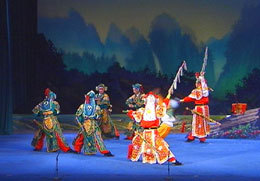 | |
As one of the major local operas of China, Chaoju has a large classic repertoire passed down over the history of 1000 years.
One audience: I started to like Chaoju since I was very young.
Another said: I’ve been a fan of Chaoju for my whole life.
And for millions of overseas Chaoshanese, the soft melody is the key to their memories of the hometown that they left behind as younglings.
 | |
It was by way of the South Sea that millions of Chaoshanese bid farewell to their hometown and embarked on their life journey. I really cannot imagine how they felt at the time not knowing where their destinations were and whether they’d ever be able to come back. Surely not as relaxed as I feel right now, coz I’m going to take some quality time at that big island ahead of me – Nan’ao Island.”
Nan’ao sits on the border of Guangdong and Fujiang Provinces, covers a total area of 109 square kilometers, and is a huge eco-tourist zone of thousands different plants and numerous migration birds.
 | |
I highly recommend you get a car and drive around the island since they’ve got a nicely-built highway circling around the whole island. Basically you can drive your way to all your destinations on the island while enjoying the spectacular sea view.
This stuff is critical when you come to Nan’ao, suntan lotion. The subtropical sunshine is really strong here.
Qing’ao is the place to first see sunrise on Nan’ao island. The beach definitely is on the par with many world-famous beach resorts. It runs for about 2.4 kilometers of extremely fine sands. And for almost 150 meters into the ocean, the water only averages at 1.2 meter deep, perfect for swimming.
I bet you’ve never done this before at any other beach resort, casting a fishnet yourself.
I’m getting the hang of it!
After that, just go about and enjoy the beach or do whatever you do, come back before dark and collect your harvest!
The island sits on the mouth of Taiwan Straights, so the wind blows hard all year round. And turns out to be a big fortune for local people now.
So here you find the largest island wind power plant in Asia.
 | |
Nan’ao island holds a strategic importance in coastal defense, can you imagine that this tiny village used to be governed by two provinces? This side being Fujiang and this side Guangdong, and the street is called Guiding Jie.
The derelict buildings and slow pace of everything seem all so serene, hardly conveying the tumultuous history the tiny village experienced over the years.
 | |
Wow, this is a big one! Banyan tree is not rare to see in south China, but this is a special one – it’s also known as the recruiting tree. Legend has it that General Zheng Chenggong of late Ming Dynasty used to recruit his soldiers under this tree to fight against invaders and pirates. And how to qualify for his army? This! You’ve got to be able to lift it up. Well, I guess I’m not qualified to be his soldier then.
General Zheng Chenggong is known in Chinese history for recovering Taiwan from the Dutch invaders.
The Nan’ao prefecture of navigation authority was set up in 1575 by Ming Dynasty to oversee the coastal defense of part of Guangdong and Fujiang provinces. More than 100 magistrates were assigned to the office over a period of 300 some years.
Nao’ao is not only known for its natural beauty, but also for the many interesting historical relics.
“For example, check this out.”
“Looks like a well to me. But it’s so close to the ocean, where does the fresh water come from? Let me find out if it is really fresh water!”
“It is fresh water, not salty at all!”
The well was built by the last emperor of Southern Song Dynasty when his government was cornered down to Nan’ao island over 700 years ago.
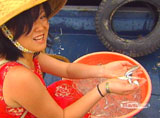 | |
Fishing is the main income for Nan’ao people. All of the fishing boats here are painted red at one end, a symbol of safety. Women usually don’t go out on a long-haul fishing trip, instead they would stay at home and pray for the safety of their men in temples worshipping Mazu, the Goddess of Sea.
The fishing trip can be arranged through travel agencies on the island.
Chaoshan people have a tradition of playing a vital importance on education. After achieving success overseas, they’d come back and build high-quality educational institutions. For example, Shantou University. Over there, looks like a group of students.
Great, I found a group of students who are majoring in photography, and they are local Chaoshanese. So why don’t we take a peek into Chaoshan culture through their lenses, what do you say?
Student: “No problem.”
Here is what I’m gonna do. I have three topics: Shantou University, Chaoshan Snackfood, and Shantou old town. I’m going to ask those three students to draw. Whoever picks whichever topic is going to make a short DV film of that topic.
Clake: Hi, my name is clake, I pick Shantou University. Let’s go!
 | |
Founded in early 1980s with the generous assistance of Li Kaisheng Foundation, Shantou University has grown into a modern institution of higher learning.
The main campus is designed by Herzog and DeMeuron, the Swiss architects behind the bird-nest stadium of 2008 Beijing Olympics.
The school makes it a mission to train students of integrity, uprightness, and critical thinking skills.
Looks like a group of travelers to me. Of course, you are free to have your own interpretation of it.
Renee: Hi, I’m Renee, I picked Chao-shan snack, my favorite topic! Come on!
Host: What’s there in “Haolao”?
Cook: Oyster, egg, flour”
“PiaoXiang Eatery” is where local people come for snack food, so it has to be good.
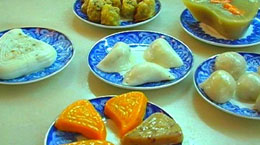 | |
Before entering Piaoxiang, make sure you are not too hungry; or you’ll end up like me - ordering off the whole menu!
Arthur: Hello, My name is Arthur. I used to live here. So why don’t I take you to chop around.
Shantou has a long history of foreign trade since opening port, so there is a strong western influence in the design of its old town. Strolling in the lanes around Xiao Gongyuan, the center of old downtown, you will find many surprising details.
Actually everything here, the dark doorway, broken window, mossy walls, look full of stories, and can go directly into a Wong Kaiwei movie.
When it comes to the art of Chaoshan traditional architecture, check out Chen Cihong former Residence in Chenghai County northeast to Shantou downtown.
Like many Chaoshanese who hit it rich overseas, Mr. Cheng Cihong spent a fortune building mega-houses back in hometown.
It is the game of “geese fight”, a traditional celebration activity of Chenghai.
 | |
It’s locked up on me! But it’s supposed to guard against theft. This is very common design here in Chaoshan area. In summer time, wind can still pass through to the courtyard. Actually, you’re not supposed to open it from the outside coz there’s a latch behind the door.
The layout of the residence follows the traditional model of “four horses pulling a cart”, referring to a central courtyard flanked by two lanes on each side.
Wow, a secret garden, and it’s almost like walking in a maze!
The whole complex covers a sprawling 25,000 square meters, and consists of altogether 506 rooms.
It is said that it would take one person a full day’s time just to open all the windows in the complex and close all of them.
And the windows rarely repeat in designs.
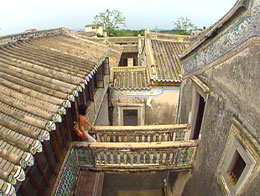 | |
The house is almost like a theme park of Chaoshan culture, you can almost find everything here, for example, this interesting puppet show!
The Chen Residence is a celebration of almost all decorations of chaoshan architecture and quite a few western elements.
Wow, take a look at this, after eighty some years, they still look brand new. All the ceramic tiles in the whole complex were imported from Spain and Italy!
It is said nearly a hundred different glazed tiles were adopted in the massive compound.
Editor:Chen Minji

